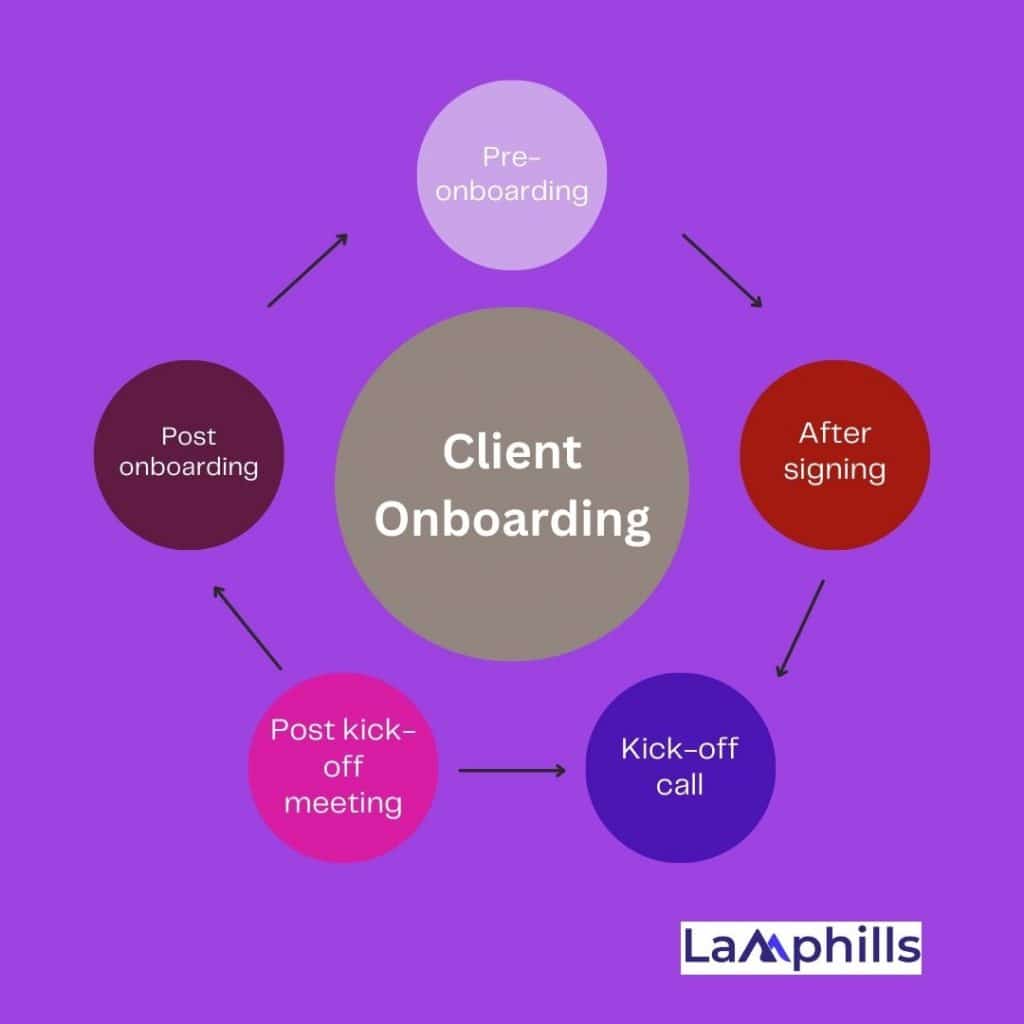Client onboarding is the critical first step that can make or break a lasting relationship. When done right, a well-executed client onboarding process sets the stage for success, demonstrating your agency’s commitment to meeting and exceeding client expectations. When done poorly, well, you wouldn’t want to thread that path, would you? Here, I’m going to show you everything you need to know about client onboarding with actionable steps to improve your process.
Key Points
- Client onboarding is the process of welcoming new clients into your business; your opportunity to begin building a strong relationship, get the client up to speed, address any queries they have, and outline the strategy going forward.
- A successful client onboarding process thrives on clear communication, proper documentation, and personalisation.
- The client onboarding process is made up of the pre-onboarding stage, the after-signing stage, the kick-off call, post kick-off meeting, and the post-onboarding stage.
What is Client Onboarding?
Client onboarding is the process of welcoming new clients into your business. It’s your opportunity to begin building a strong relationship, get the client up to speed, address any queries they have, and outline the strategy going forward. The goal of this process is to assure the client that they made the right choice and that your team will carry out all the promises it made during the sales process.
Client onboarding is more than just a procedural step—it’s the foundation of your client’s journey with your business. It encompasses everything from the initial introduction to the establishment of a working relationship, ensuring that clients feel valued, understood, and supported from day one.
A well-executed onboarding process streamlines internal operations, making it easier to manage client interactions and expectations.
Key Elements of a Successful Client Onboarding Process

The client onboarding process is simple, but it yields good results when carried out effectively. When you can hook clients, and build trust, you’ll create a strong foundation for a future relationship with them. Without that strong foundation, your relationship will crumble. Over the years, I’ve identified several key elements that are important for an effective client onboarding process, and I have outlined them below:
#1. Clear Communication
It’s important to set expectations from the start. I’ve learned over time that assumptions could lead to a lot of misunderstandings. From the pre-onboarding process to the closing stage, ensure that every detail is communicated clearly, with regular updates and check-ins to keep everyone on the same page.
#2. Documentation and Resources
It’s also important to provide clients with the necessary materials and guides they need. I started taking this seriously after almost losing a client due to a lack of proper documentation.
#3. Personalization
Every client is unique, and their onboarding experience should reflect that. Tailoring the process to meet individual needs not only makes clients feel special but also addresses their specific challenges and goals effectively.
Well, these are just the basics you need to know about client onboarding. Let’s get into the onboarding process properly.
Steps In The Client Onboarding Process

#1. Pre-Onboarding
This includes the activities and tasks performed by the sales team with onboarding in mind. Here are the activities involved in this step:
Identify customer pains and solutions.
The sales qualification process is where you determine whether the prospect is a good fit for you and your needs for your services. You clearly understand their pain points and are communicating how your product or service will address them. Clarity is very important here, as you wouldn’t want to make mistakes when the actual onboarding takes place.
Define big-picture campaign goals.
The pre-onboarding stage is also where you discuss your client’s ideas and goals. Define what they want to achieve and don’t forget the numbers. Here, it is important to assess project goals, expectations, and desired outcomes before discussing how you will collaborate to make them actionable and attainable. In many circumstances, you’ll have to strike a balance between what the client wants to achieve, the resources available, and your team’s time and effort.
Agree on mutual deliverables.
When creating a proposal or service contract, the terms of the agreement should be clearly outlined. The scope and deliverables should be based on the client’s objectives and your company’s practical capabilities. They should be clearly stated for the client before work begins.
#2. After Signing
At this stage, you have gotten the client to accept your proposal, and they must have made the first payment. You need to keep up with the energy you started with while prospecting and eliminate any uncertainties as well. Here are some steps you should take:
Send a welcome message.
One thing you can do is immediately send a welcome message or email after the proposal is submitted. The point of this is to first assure them that they did the right thing by joining your company and to set expectations for onboarding.
Consider including a timeline for the next steps, and inform them that your team is excited to have them on board.
Schedule a call.
Even if you send a packet or email, your new customer will still need a personal experience. Have one of your team members call the client to welcome them and ask if they have any questions or concerns. It’s also good to take this time to organize the kick-off call and set expectations for it.
#3. Kick-Off Call
The kick-off call is the formal introduction between the client and your team members who will be handling/working the account. It sets the tone for the rest of the engagement, so here’s what you’ll want to accomplish:
Collect information about their internal process.
If you’re picking up where your client’s team left off, you should find out what the existing process looks like and what their preferences are. Otherwise, ask about how they want to manage the relationship and what they expect from the collaboration.
Find out the client’s definition of success.
Your team needs to hear directly from the client what their goals are, even though your sales rep must have done so. This will help to ensure that everybody is on the same page.
Revisit the deliverables.
The team likely understands better about the work being performed, so once they understand the client’s expectations, now is the time to confirm that the agreed-upon deliverables are appropriate and achievable.
Reinforce the value you’re providing.
Be sure to handle any last-minute objections by sharing information that will banish buyer’s remorse (such as introducing your team’s specialties or any strategies you have for their success).
Outline action items for both parties.
Both you and the client will have to deliver content and collateral to make the campaign a success. Nail down everything needed for the project, who will be responsible for what, and firm deadlines for submitting collateral.
#4. Post Kick-Off Meeting
Once the kick-off call is complete, set your first regular check-in to evaluate progress made and for both parties to offer feedback. Here are some best practices for the call:
Revisit your client’s definition of success.
Your account manager cannot influence the customer’s thoughts if they do not have access to all of the work being done. Consider this meeting to be a course adjustment. It is important to remind the client of what they still stand to gain and why they got into the engagement, especially at the start when there may be no tangible outcomes or deliverables.
Create an SLA.
A service-level agreement (SLA) is a contract that establishes a set of deliverables between one party and another. This will be more specific than the proposal and may be adjusted as goals or needs change. It’s important to establish what they need from you, and what you need from them to accomplish it.
Agree on smaller milestones.
You know that Rome wasn’t built in a day, but when your customer continues writing checks, they may lose perspective and get antsy. Smaller milestone goals on the way to a larger goal show progress and get buy-in. If you miss a milestone, it also gives you room to manage expectations and adjust the plan.
After Onboarding
Now, the onboarding is likely concluded, your client is used to your systems, and they are expecting results. Even though the official onboarding process is probably over, you shouldn’t loosen up on client management just yet. Your account manager needs to follow the communication schedule and complete the following duties at every meeting:
- Find ways to continue establishing trust.
- Notify the client of milestones achieved and tasks completed.
- Ask for feedback to identify small issues before they become engagement-ending problems.
- Complete a health check report post-call to notify the rep and team of customer sentiment.
Here’s a checklist you can always refer to:
Tools and Technologies to Enhance Client Onboarding
Leveraging the right tools and technologies can significantly enhance the onboarding process. Over the years, I’ve discovered how integrating specific tools into our workflow has not only streamlined our onboarding but also enriched the client experience. Some of the tools you need for effective client onboarding include:
CRM Systems
Managing client information and interactions becomes much more manageable with a robust Customer Relationship Management (CRM) system. A CRM allows you to store all client data in one place, track interactions, and monitor progress. I recall how our CRM system once saved us from a potential disaster by flagging a missed follow-up, allowing us to quickly reconnect with the client and keep the onboarding process on track. CRMs ensure that no detail is overlooked, providing a comprehensive view of each client’s journey and enabling you to offer a personalized onboarding experience.
Onboarding Software
Automation can streamline many aspects of onboarding, making the process more efficient and consistent. Onboarding software saves you the stress of repetitively sending welcome emails and scheduling meetings by automating these tasks. I remember a period when we manually handled these tasks, which often led to delays and occasional errors. Implementing onboarding software transformed our process, ensuring that every client received timely and accurate information. This automation not only saves time but also frees up our team to focus on more strategic activities, such as customizing onboarding plans and addressing unique client needs.
Here are some examples of onboarding software you can use:
#1. Content Snare: Best for collecting content & documents
Content Snare makes it easy to gather information, content and marketing assets from clients. It automates much of the process, like automatically chasing clients, so you can spend more time doing your work instead of chasing clients for info or files.
With Content Snare, clients can easily fill out onboarding questionnaires and deliver the content you need on time. The system supports respondents with intuitive field types, while you can add instructions to explain exactly what you need. Your clients can even post questions directly within questionnaires to ask for further clarification.
#2. DocuSign: for signing contracts
DocuSign is a digital signature tool that helps collect signatures on contracts and other documents. It’s a fast and reliable way to sign documents electronically. Using DocuSign makes the contract signing process faster and easier for you and your new client.
As soon as everyone has signed the document, you and your new client will receive an email notification from DocuSign to confirm that the document has been fully executed.
#3. Notion: for organizing information
This is an all-in-one project management tool that creates a collaborative workspace for notes, projects, tasks, databases, and more. Users can connect their teams, projects, and documents in one place. It’s ideal for centralizing information.
It’s fantastic for keeping track of your client onboarding checklist and organizing your timeline. And you can customize Notion to suit your needs and build the workflow you want.
#4. JotForm: for collecting information & surveys
JotForm is another excellent form-building tool you can use to collect client information. With over 10,000+ form templates, this customer onboarding software has the largest selection of free form templates on the web!
With a variety of features and integrations, JotForm can facilitate various onboarding tasks, ranging from collecting e-signatures to taking payment within forms using different payment processors.
#5. ClickUp: for project management
This is one of my favorite project management tools. ClickUp allows you to plan, manage, and track any project. You can set priorities, share dashboards, and manage marketing campaigns through simple workflow management. You can also share documents for collaboration and even plan out content calendars within the app.
The product’s tagline is ‘one app to replace them all’ and certainly delivers on this promise. It even has a CRM feature, so you can keep all your client information in one place and not have to switch between programs.
Communication Platforms
Consistent and clear communication is vital for a successful onboarding process. Using platforms that facilitate seamless communication helps maintain regular contact with clients. Tools like Slack, Microsoft Teams, or even dedicated client portals ensure that clients can easily reach out with questions or concerns. I once had a client who appreciated the real-time updates and quick responses possible through our communication platform, which helped build trust and confidence early in the relationship. These platforms also support file sharing, video calls, and collaborative workspaces, enhancing the overall onboarding experience by keeping everyone connected and informed.
In Conclusion,
A well-structured client onboarding process is essential for building strong, lasting relationships. By focusing on clear communication, providing comprehensive resources, and personalizing the experience, you can ensure client satisfaction and retention for your business. I encourage you to evaluate your onboarding process and make necessary improvements—you’ll be glad you did.
Related Articles
- New Hire Press Release: Effective Steps & Tips to Writing a New Hire Press Release
- Top PR Tracking Tools of 2024: Navigating the PR Landscape
- Social Media Etiquette: Best Practices
- Internal Communications for PR Success: Aligning Your Team and Keeping Everyone on Message






